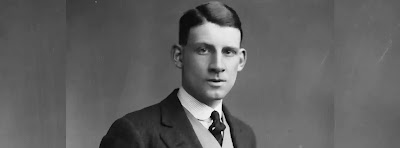Also Read
Siegfried Sassoon (1336-1967) based nearly all his most worth-while work on his experiences in the War. Educated at Marlborough and Cambridge, he saw infantry service in Western Europe and Palestine and was decorated for gallantry. First-hand knowledge of the conditions of trench warfare produced in him a bitter disillusionment, a brief period as a conscientious objector, and, above all, a determination to shock the people at home into a realization of the ghastly truth.
 |
| Siegfried Sassoon |
Counter-attack (1918), a collection of violent, embittered poems, confirmed the notoriety which had rapidly grown out of his occasional writings for periodicals, and it is still the best known of his collections of poetry. With a studied bluntness and often a provocative coarseness of language, Sassoon painted the horrors of life and death in the trenches, dugouts, and hospitals, and a merciless and calculated realism gave to his work a vitality not previously found in our war poetry.
Some critics have found his horrors mechanical or exaggerated, but he still maintains his reputation among readers of poetry. Should that eventually decline, to his credit will always remain the fact that his was the work to inspire the greatest of all the war poets, Wilfred Owen. In a similar vein to Counter-attack, though less successful, were War Poems (1919) and Satirical Poems (1926), but his more recent volumes, The Heart's Journey (1928) and Vigils (1935), were more concerned with attempts to capture for his reader momentary impressions of beauty. Collected Poems was published in 1947.
Sassoon also achieved eminence as a writer of prose. Memoirs of a Fox hunting Man, which won the Hawthornden Prize in 1929, Memoirs of an Infantry Officer (1930), and Sherston's Progress (1936), collected in 1937 as The Complete Memoirs of George Sherston, are thinly disguised autobiographies, the last two volumes of which deal mainly with Sassoon's war-time experiences, and this perennial theme is taken up again in Siegfried's Journey (1945). The Old Century (1938), The Weald of Youth (1942), and a biography of George Meredith published in 1948 are his other recent books. His style is simple, lucid, and most appealing, and his handling of language betrays the poet's great sensitivity. A lover of the countryside, of rural sports, of music and painting, Sassoon represented a class which is now fast disappearing, and his work gives an admirable picture of a life of cultured leisure.